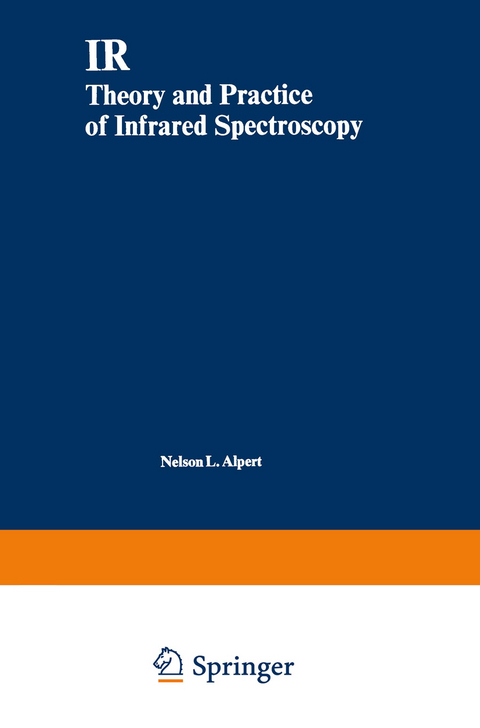
IR
Springer-Verlag New York Inc.
978-1-4684-8162-4 (ISBN)
1 Introduction to Infrared Spectroscopy.- 1.1. Units.- 1.2. Regions of Electromagnetic Radiation.- 1.3. The Infrared Spectrum of a Compound.- 1.4. Atmospheric Absorptions.- 2 Instruments.- 2.1. Description.- 2.2. Operating Variables.- 2.3. Components of Infrared Spectrophotometers.- 2.4. Special Operating Features.- 2.5. Available Instruments and Their Specifications.- 2.6. The Computer Revolution.- References.- 3 Accessories.- 3.1. Crystals.- 3.2. Gas Cells.- 3.3. Liquid Cells.- 3.4. KBr-Pellet Accessories.- 3.5. Beam Condensers.- 3.6. Polarizers.- 3.7. Specular Reflectance.- 3.8. ATR.- 3.9. Miscellany.- References.- 4 Theoretical Considerations in Infrared Spectroscopy.- 4.1. Notation.- 4.2. Diatomic Molecules.- 4.3. Polyatomic Molecules.- 4.4. The Relationship Between Symmetry of Molecules and Observed Absorption Bands.- 4.5. Character Tables and Types (Species) of Vibrations.- 4.6. Molecules with Centers of Symmetry.- 4.7. Correlation of Species of Related Molecules.- 4.8. Calculation of Allowed Bands Using Group Theory.- 4.9. Factors Influencing Band Positions and Band Contours in Polyatomic Molecules.- 4.10. Band Contours for Linear Molecules.- 4.11. The Method of Combination Differences Used to Obtain Rotational Constants of Diatomic and Linear Molecules.- 4.12. Vibrational-Rotational Energy Equations for the Symmetric Rotor.- 4.13. Analysis of the Ammonia Spectrum (Symmetric Rotor).- 4.14. Spherical Rotor Molecules.- 4.15. The Asymmetric Rotor.- 4.16. Spectral Analysis of Formaldehyde (Near Symmetric Rotor).- 4.17. Fundamental Frequencies of the Molecules CF2=CH2, CF2=CHD, and CF2=CD2.- 4.18. The Influence of Isotopic Substitution on Band Position.- 4.19. Conclusion.- References.- 5 The Use of Characteristic Group Frequencies in Structural Analysis.- 5.1. General Objectives.- 5.2. Definition of Group Frequencies.- 5.3. Group Frequencies and the Vibrational Analysis of a Molecule.- 5.4. Group Frequencies of the CH3, CH2, and CH Structural Units.- 5.5. Group Frequencies Associated with Alkenes.- 5.6. Group Frequencies Associated with Alkynes.- 5.7. Characteristic Group Frequencies for Benzene Derivatives.- 5.8. Vibrations of Pyridine and Its Derivatives.- 5.9. Group Frequencies Associated with the C=O Structural Unit.- 5.10. Group Frequencies Associated with the C—O—C and C—O—H Structural Units.- 5.11. Group Frequencies Associated with NH and CN Structural Units.- 5.12. Amide I Band.- 5.13. Amide II Band.- 5.14. Amide III, IV, V, and VI Bands.- 5.15. Group Frequencies for Fluorocarbons.- 5.16. Group Frequencies for the C=N, N=O, C?N, and Other Structural Units.- 5.17. Organic Molecules Coordinated to Inorganic Salts.- 5.18. Practice Interpretation of Spectra.- References.- 6 Quantitative Analysis.- 6.1. Beer’s Law.- 6.2. Analysis of a Series of Samples.- 6.3. Multicomponent Analysis.- 6.4. Solid Samples.- 6.5. Gas Samples.- 6.6. “One-Time” Analysis.- 6.7. Sources of Error.- 6.8. Noninterchangeability of Data.- 6.9. Measuring Absorbance.- 6.10. Accuracy.- 6.11. Other Techniques.- 6.12. Literature.- Reference.- 7 Sample-Handling Techniques.- 7.1. Gases.- 7.2. Liquids.- 7.3. Solids.- 7.4. Miscellany.- 7.5. Microsampling.- 7.6. Conclusions.- References.- 8 Spectra and Reference Library.- 8.1. General References to Infrared Spectroscopy.- 8.2. Government Publications.- 8.3. House Organs of Various Companies and Laboratories.- 8.4. Reference Spectrograms and Spectral Retrieval Systems.- 8.5. Abstracting Services and Bibliographies.- Appendixes.- Appendix 1. Additional References.- Appendix 2. Character Tables of theMost Important Point Groups.
| Erscheint lt. Verlag | 22.6.2012 |
|---|---|
| Zusatzinfo | XIV, 381 p. |
| Verlagsort | New York, NY |
| Sprache | englisch |
| Maße | 152 x 229 mm |
| Themenwelt | Naturwissenschaften ► Physik / Astronomie ► Astronomie / Astrophysik |
| ISBN-10 | 1-4684-8162-2 / 1468481622 |
| ISBN-13 | 978-1-4684-8162-4 / 9781468481624 |
| Zustand | Neuware |
| Haben Sie eine Frage zum Produkt? |
aus dem Bereich


